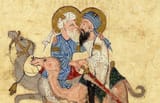Search Results
7/4/2025, 10:47:05 PM
>>509520181
At the height of the Islamic Golden Age – a period from the mid-8th century to the mid-13th century when Islamic civilization is believed to have reached its intellectual and cultural zenith – homosexuality was openly spoken and written about. Abu Nuwas (756-814), one of the great Arab classical poets during the time of the Abbasid Caliphate, wrote publicly about his homosexual desires and relations. His homoerotic poetry was openly circulated right up until the 20th century. Most modern Muslims, therefore, have little knowledge of what the Islamic Golden Age was really about, even though they keep on wanting to go back to it.
As historian Saleem Kidwai puts in the fabulous book Same-Sex Love in India, “Homoerotically inclined men are continuously visible in Muslim medieval histories and are generally described without pejorative comment.”
Mahmud of Ghazni, a towering sultan of his time (971-1030), was actually held up as an ideal for, among other things, deeply loving another man, Malik Ayaz.
Mughal Emperor Babur wrote of his attraction to a boy in the camp bazaar in his 16th-century autobiography – a celebrated work of literature in the medieval Muslim world.
In the 18th century, Dargah Quli Khan, a nobleman from the Deccan travelling to Delhi, wrote a fascinating account of the city called theMuraqqa-e-Dehli (The Delhi Album), which described just how mundane homosexuality was in Indo-Islamic society. At the public bazaars, male prostitutes solicited openly and Khan spoke admiringly of how “young good-looking men danced everywhere and created great excitement”.
At the height of the Islamic Golden Age – a period from the mid-8th century to the mid-13th century when Islamic civilization is believed to have reached its intellectual and cultural zenith – homosexuality was openly spoken and written about. Abu Nuwas (756-814), one of the great Arab classical poets during the time of the Abbasid Caliphate, wrote publicly about his homosexual desires and relations. His homoerotic poetry was openly circulated right up until the 20th century. Most modern Muslims, therefore, have little knowledge of what the Islamic Golden Age was really about, even though they keep on wanting to go back to it.
As historian Saleem Kidwai puts in the fabulous book Same-Sex Love in India, “Homoerotically inclined men are continuously visible in Muslim medieval histories and are generally described without pejorative comment.”
Mahmud of Ghazni, a towering sultan of his time (971-1030), was actually held up as an ideal for, among other things, deeply loving another man, Malik Ayaz.
Mughal Emperor Babur wrote of his attraction to a boy in the camp bazaar in his 16th-century autobiography – a celebrated work of literature in the medieval Muslim world.
In the 18th century, Dargah Quli Khan, a nobleman from the Deccan travelling to Delhi, wrote a fascinating account of the city called theMuraqqa-e-Dehli (The Delhi Album), which described just how mundane homosexuality was in Indo-Islamic society. At the public bazaars, male prostitutes solicited openly and Khan spoke admiringly of how “young good-looking men danced everywhere and created great excitement”.
Page 1
